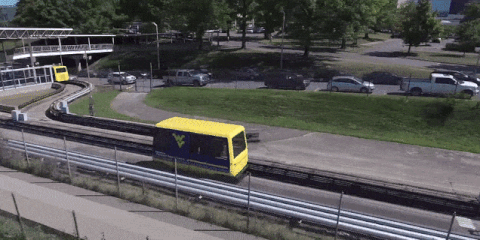The Self-Driving Pod-Car Future That Wasn't

In 2016, the self-driving-car future feels like it's going to arrive eventually, but might take a couple of decades before it actually shows up. But in 1975, it already had. Sort of.
West Virginia University had just unveiled its Morgantown Personal Rapid Transit (PRT) system, a series of computer-driven cars that puttered their way through a series of closed-off tracks to take students to and from different points on campus with non-stop trips, even in the most inclement weather.
Here's how Popular Mechanics described the system in an issue from 1973:
Not many college students have their own rapid-transit system like those at West Virginia University at Morgantown, W. Va. Small electric-power cars scoot back and forth across university grounds on elevated trestles, whisking the lucky students to and from classes without their having to poke their noses outside. the cars are actually part of an experimental, high-speed automated transportation system being developed at the university for future public use. Stopping, starting, switching, and routing of cars to various destinations are fully computer-controlled.
The system is still running today, after 40 years of consistent operation. Users simply sidle up to a stop, press a button, and a car arrives to take them to their destination without any stops. While the pods are computer-controlled, they don't really have to steer since the roadways are hemmed in on either side by guiding barriers. The pods do, however, negotiate the forks in the road all by themselves, as opposed to trains, which are guided by physical changes in the tracks.
Tom Scott explains in more detail in this video on (literally) the fantastic system:
Ultimately the pod-cars weren't the future because installing such a system was more expensive than light rail, but not that much more efficient. Sure, pod-cars could offer non-stop trips, but that small luxury wasn't enough to offset the enormous cost. Still, the actual user experience-pressing a button, getting a car, and then zoning out until it drops you off at your destination-is a fascinating glimpse into a future that might still get her, albeit not for a few more years.
Source: Tom Scott
You Might Also Like

 Yahoo Autos
Yahoo Autos 